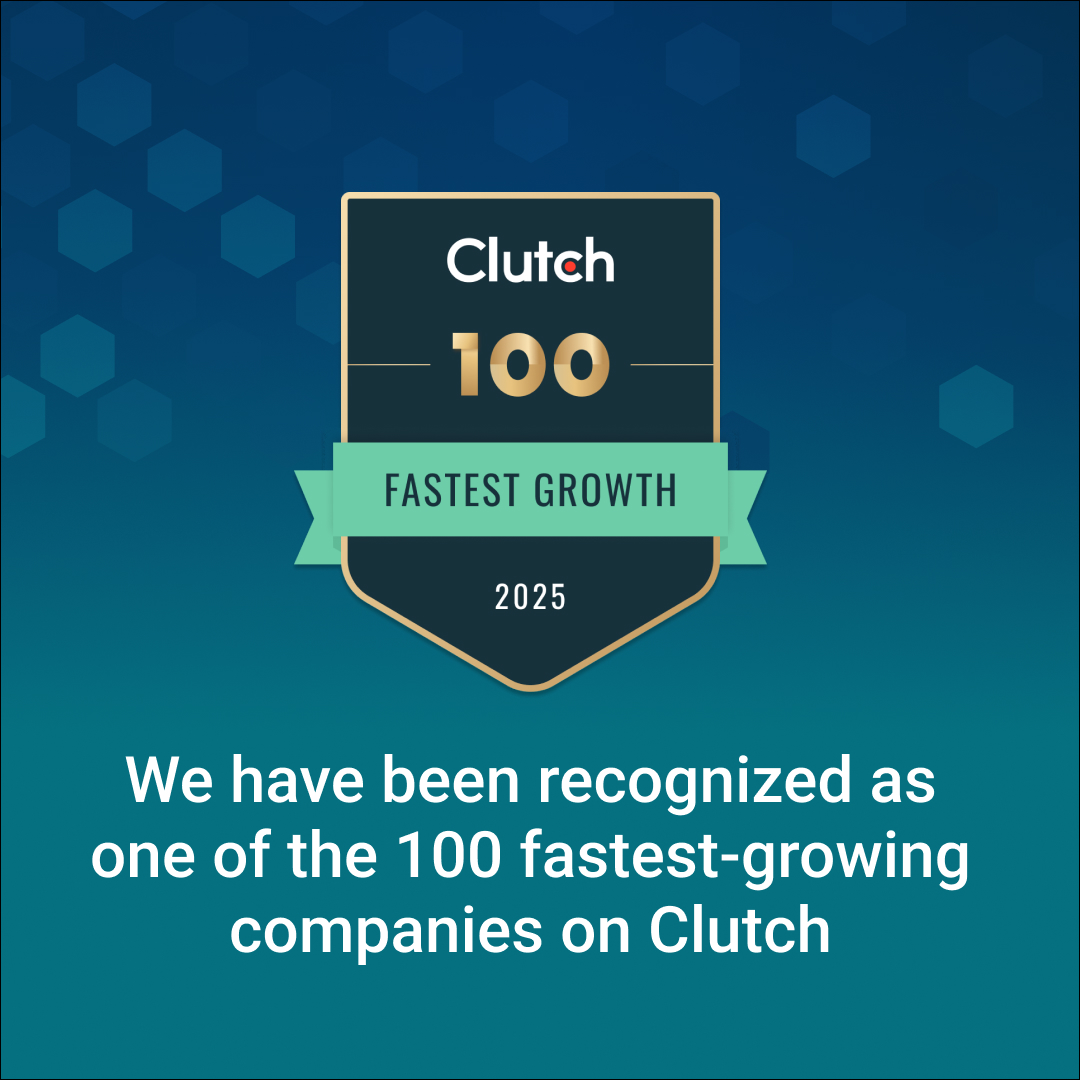Einführung
Procurement is under pressure – from rising costs to supply chain risks and demand for smarter decisions.
AI tackles these challenges head-on: automating negotiations, predicting disruptions, optimizing inventory, and enhancing spend visibility.
This guide explores how AI-driven use cases are transforming procurement into a strategic advantage for your business.
What is AI and Why Does It Matter in Procurement?
Procurement is no longer just about negotiating prices – it’s about making smarter, faster decisions in a volatile world.
AI is stepping in as the game-changer, helping you turn complex data into powerful, real-time actions.
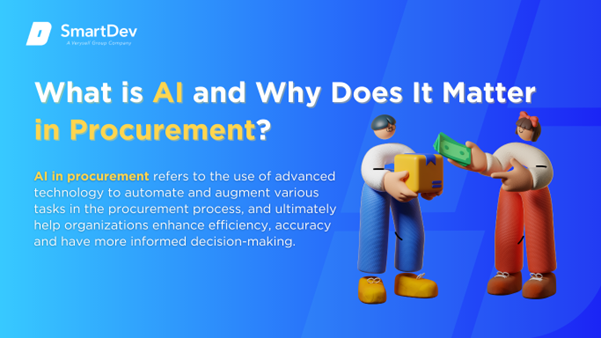
Definition von KI und ihren Kerntechnologien
AI refers to computer systems designed to perform tasks that typically require human intelligence, including learning, reasoning, problem-solving, and decision-making.
According to IBM, AI encompasses various technologies that enable machines to sense, comprehend, act, and learn with human-like intelligence.
AI in procurement refers to the use of advanced technology to automate and augment various tasks in the procurement process, ultimately helping organizations enhance efficiency, improve accuracy, and make more informed decisions.
The Growing Role of AI in Transforming Procurement:
AI has only lately been used in procurement, but it has the potential to completely change how your business operates today. Given the enormous volumes of internal and external data needed for procurement, AI solutions may be essential in assisting businesses in analyzing and creating new tools that will improve cost optimization and sourcing decisions.
Modernizing internal technology might be crucial to ensuring ongoing advancements that assist supply chain, Finanzen, and accounting managers in addition to procurement. Your procurement team can create more accurate forecasting and predictive analytics models by mastering the data.
Companies must gain a deeper understanding of their current structured data sources if they hope to remain competitive in the market. AI and processing power improvements can help businesses expand their existing structured data as well as data from unstructured sources like rate tables and invoices.
Key Statistics and Trends Highlighting AI Adoption in Procurement:
As companies look to streamline their operations, AI in procurement is making waves with impressive results. Gartner’s 2023 report notes that 65% of procurement leaders plan to embrace AI by 2025, drawn by its potential to cut costs by up to 20%. Tools like automated supplier evaluations are reshaping how teams like yours prioritize strategy.
Efficiency is a key driver, with clear gains for early adopters. McKinsey’s 2024 study shows that AI in procurement can reduce operational costs by 20% and boost productivity by 70%. These advancements will allow you to focus more on strategic decisions, ultimately driving better outcomes for your business.
The future of AI in procurement is promising, with the global market projected to reach $22.6 billion by 2033, growing at a 28.1% CAGR from $1.9 billion in 2023, according to a market.us report. Innovations like predictive analytics and contract automation are driving this expansion. Companies adopting AI today are well-positioned to lead in efficiency and innovation.
Business Benefits of AI in Procurement:
As procurement grows more complex, AI offers clear advantages. From boosting productivity to cutting costs and improving quality, AI’s impact on your business is both immediate and strategic.
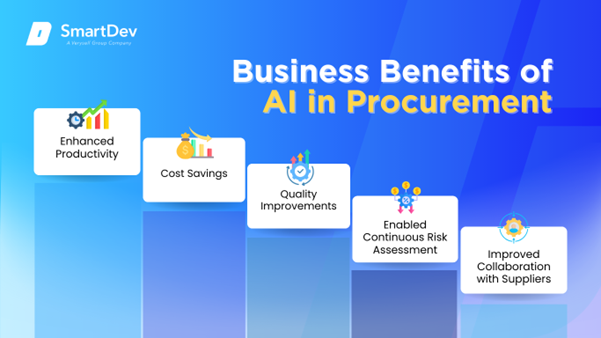
1. Enhanced Productivity
AI in procurement automates repetitive tasks like invoice processing and supplier evaluations, freeing teams for strategic work. By streamlining workflows, it accelerates decision-making and reduces manual effort.
This shift allows you to prioritize high-impact initiatives, boosting overall efficiency.
Predictive analytics refines procurement processes by forecasting demand and supplier performance with precision. Real-time insights minimize delays and optimize resource allocation.
As a result, organizations handle larger workloads without increasing staff, directly linking to the transformative power of AI in procurement.
2. Kosteneinsparungen
AI identifies cost-saving opportunities by analyzing your spending patterns and optimizing supplier contracts. It helps you reduce errors in invoice reconciliation and compliance, cutting operational expenses.
A 2024 McKinsey study reports that AI in procurement can lower costs by up to 20%.
Automation decreases reliance on manual labor, further driving down overhead. These savings enable businesses to redirect funds toward innovation or expansion.
The cost-efficiency benefits of AI in procurement make it a cornerstone for financial optimization.
3. Quality Improvements
AI enhances sourcing decisions by evaluating supplier reliability and product standards through data analysis. It ensures consistent quality by identifying the best partners and materials for each project.
This precision strengthens supply chains and elevates end-product quality, a key advantage of AI in procurement.
By refining contract terms and monitoring compliance, AI minimizes risks of errors or disputes. It detects discrepancies in agreements, ensuring alignment with organizational goals.
Improved quality control fosters stronger supplier relationships and customer trust.
4. Enabled Continuous Risk Assessment
AI strengthens procurement security by monitoring transactions and payments in real time, flagging potential fraud or compliance issues as they arise.
This proactive approach helps your business to protect financial assets and ensures smoother, more reliable operations.
It also enables continuous risk assessment by analyzing supplier behavior, financial stability, and external factors like geopolitical events or ESG concerns.
According to a 2022 Ivalua report, 66% of procurement professionals use AI to manage supplier risks and build more resilient supply chains.
5. Improved Collaboration with Suppliers
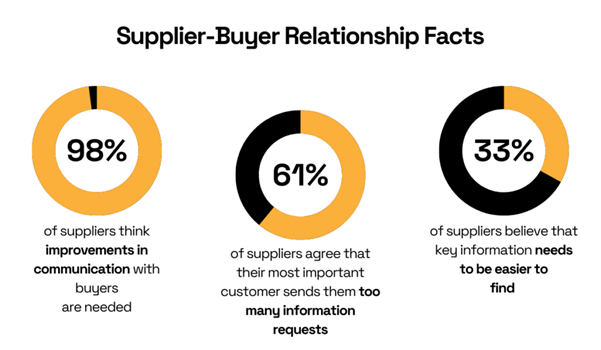
AI enhances transparency and real-time communication between buyers and suppliers, leading to faster response times and smoother coordination.
This aligns with what suppliers value most — according to the 2024 HICX survey, 98% believe better communication from clients is long overdue.
By automating routine tasks like quote collection and contract negotiation, AI-powered tools streamline interactions and reduce miscommunication.
This not only improves operational efficiency but also strengthens trust and collaboration in supplier relationships.
Challenges Facing AI Adoption in Procurement:
AI holds great potential for procurement, but turning potential into real-world impact presents serious hurdles.
Procurement leaders like you will face unique challenges when bringing AI into the fold.
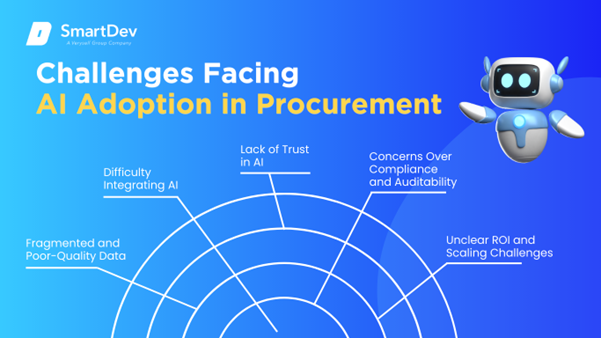
1. Fragmented and Poor-Quality Data
Procurement runs on supplier data, yet much of it is fragmented across spreadsheets, emails, and disconnected platforms.
Without clean, centralized records, AI solutions struggle to generate reliable insights or automate supplier selection and risk management.
Unifying supplier master data and maintaining its accuracy is more than a technical task.
It requires strong data ownership, ongoing cleansing, and alignment across procurement, finance, and operations — often a major organizational challenge.
2. Difficulty Integrating AI with Legacy Procurement Systems
Many procurement processes are still anchored in outdated ERP and sourcing platforms not designed for AI.
Connecting AI tools to these systems can be technically complex and expensive, slowing down implementation efforts.
Without tight integration, AI-generated recommendations cannot flow naturally into sourcing events, contract negotiations, or order management.
This creates friction and forces your procurement teams to continue working across disconnected systems.
3. Lack of Trust in AI for Supplier Selection and Negotiation
Procurement professionals are accustomed to controlling supplier relationships and negotiating deals based on experience and intuition.
Relying on AI-generated suggestions for supplier choice or pricing can raise concerns about losing control or missing context.
Building trust takes time.
AI outputs need to be transparent, explainable, and augment — not replace — human judgment to gain acceptance among sourcing managers and category leads.
4. Concerns Over Compliance and Auditability
Procurement operates in a highly regulated environment where decisions must be documented and auditable.
Introducing AI raises questions about how sourcing choices are made and whether AI-driven processes meet internal and external compliance requirements.
Ensuring audit trails and embedding governance into AI systems is non-negotiable.
Without this, your organizations risk regulatory scrutiny and damage to supplier relationships.
5. Unclear ROI and Scaling Challenges
While pilot AI projects often show promise, scaling across procurement categories and regions introduces complexity.
Different categories have varying sourcing processes, supplier landscapes, and risk profiles that AI models must adapt to.
Proving ROI beyond initial use cases can be difficult.
Procurement leaders must carefully select metrics and success stories to build the business case for broader AI adoption across the function.
Specific Applications of AI in Procurement:
AI in procurement is moving from theory to action.
Across negotiations, supplier management, and risk mitigation, AI-powered tools are driving smarter, faster, and more consistent decisions where they matter most.
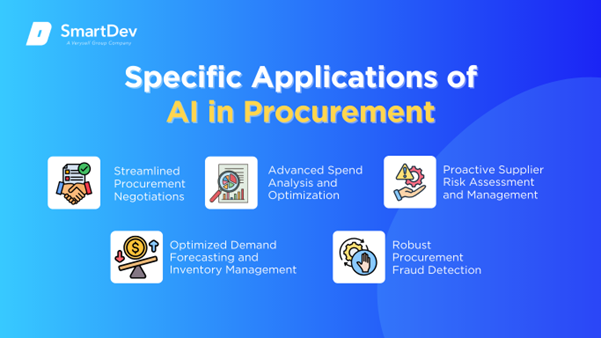
1. Streamlined Procurement Negotiations
Negotiation is a critical part of procurement, but traditional approaches often rely heavily on human intuition, past experience, and static data.
This can lead to inconsistencies, missed savings opportunities, and extended negotiation cycles.
AI addresses these challenges by introducing data-driven precision and speed into the process.
AI-powered tools analyze supplier behavior, pricing trends, and historical contract data to recommend optimal strategies, with Gartner predicting that by 2027, 50% of organizations will use AI-enabled tools for contract risk analysis and editing in supplier negotiations.
Natural language processing (NLP) interprets communications, suggesting timely responses and simulating scenarios.
Real-World Case Study: Walmart
Walmart utilizes AI-powered chatbots to streamline procurement negotiations, especially with tail-end suppliers.
The chatbot automates the entire negotiation process, using NLP to analyze supplier communication and propose optimal terms based on historical data and market trends.
This automation allows Walmart to efficiently manage a large volume of supplier contracts with minimal manual effort.
As a result, Walmart saves time, improves negotiation terms, and reduces human error, all while enhancing the flexibility of its supply chain.
The AI-driven approach not only generates cost savings but also strengthens supplier relationships and boosts the resilience of Walmart’s procurement operations.
2. Advanced Spend Analysis and Optimization
Traditional spend analysis relies on manual data aggregation, often missing hidden savings opportunities.
AI in procurement automates this process, uncovering patterns in spending data with unmatched accuracy.
It enables procurement teams to optimize budgets and drive cost efficiency.
AI tools leverage machine learning to categorize expenses, identify anomalies, and suggest cost-saving measures in real time.
By integrating internal and external data, such as market pricing and supplier performance, AI provides actionable insights for strategic sourcing.
This approach ensures consistent savings and informed decision-making.
Real-World Case Study: Unilever
Unilever leverages AI in procurement to optimize spend analysis for its ice cream division, managing a supply chain with 35 factories and an estimated 3 million freezers across 60 countries.
AI analyzes procurement data, including raw material and logistics costs, alongside weather data to adjust sales forecasts and reduce waste, achieving significant cost reductions.
Data from 100,000 AI-enabled freezers provides real-time insights, boosting retail orders and sales by up to 30%.
This allows Unilever to fine-tune supplier contracts and streamline logistics, ensuring alignment with demand and sustainability goals.
The result is a leaner, more resilient supply chain that enhances competitiveness and drives long-term value.
3. Proactive Supplier Risk Assessment and Management
Traditional supplier risk management often struggles with incomplete data and slow manual processes, leaving businesses vulnerable to disruptions.
AI in procurement transforms this by continuously analyzing vast datasets to identify and prioritize risks in real time.
It ensures supply chain resilience by enabling swift, informed responses to potential threats.
AI leverages predictive analytics to assess supplier financial stability, geopolitical exposures, and ESG compliance, uncovering risks that might otherwise go unnoticed.
By integrating external data sources like news feeds and market trends, it provides a holistic view of supplier reliability.
Real-World Case Study: Audi
Audi uses AI in procurement to monitor risks across its supply chain of over 14,000 direct suppliers in 60+ countries.
Partnering with Prewave since 2020, Audi’s AI system analyzes media and social networks in 50+ languages, flagging sustainability risks like human rights violations or environmental issues in real time.
This AI-driven approach, combined with Audi’s mandatory Sustainability Rating for suppliers, ensures compliance with its Code of Conduct.
By integrating AI insights with audits and training, Audi strengthens supplier relationships and supports its 2050 net carbon neutrality goal, enhancing supply chain resilience and sustainability.
4. Optimized Demand Forecasting and Inventory Management
Inaccurate demand forecasting leads to overstocking or stockouts, impacting costs and customer satisfaction.
AI in procurement enhances forecasting accuracy by analyzing historical sales, market trends, and external factors like seasonality.
It aligns inventory with actual demand, minimizing waste.
Machine learning models predict demand fluctuations and optimize inventory levels in real time, reducing carrying costs.
AI also integrates supplier lead times and production schedules for seamless inventory management.
This precision ensures operational efficiency and supports just-in-time strategies.
Real-World Case Study: Amazon
Amazon uses AI in procurement to forecast demand for over 400 million products, powering its Supply Chain Optimization Technology (SCOT) to handle 5 billion U.S. packages yearly.
During 2023’s Cyber Monday, AI analyzed historical data with deep learning, optimizing stock placement and reducing excess inventory by 20%.
Its AI-driven Sequoia robotic system stores inventory 75% faster, managing warehouses with 60,000 – 110,000 daily packages during peak seasons.
This efficiency ensures product availability, cuts costs, and accelerates Amazon’s supply chain, reinforcing its market leadership.
5. Robust Procurement Fraud Detection
Procurement fraud, such as invoice manipulation or supplier collusion, undermines financial integrity and erodes trust.
AI in procurement counters this by analyzing vast transaction datasets in real time to identify suspicious patterns.
It ensures compliance and protects organizations from significant losses.
AI employs advanced anomaly detection to flag irregularities like duplicate invoices, inflated prices, or unusual payment requests with high precision.
By integrating machine learning with behavioral analysis, it distinguishes legitimate transactions from potential fraud, adapting to evolving tactics.
Real-World Case Study: IBM
IBM leverages AI in procurement to monitor its global supplier network, analyzing millions of transactions to detect fraud.
In a 2023 pilot, IBM’s AI system, built with machine learning and anomaly detection, identified 85% of potential fraud cases, including duplicate invoices and unauthorized payments, saving millions in losses.
The system cross-references supplier data, payment histories, and market benchmarks to flag risks in real time, enabling rapid response.
This proactive approach not only strengthens IBM’s financial security but also reinforces trust across its procurement ecosystem, ensuring operational integrity and compliance.
Examples of AI in Procurement:
Fallstudien aus der Praxis
AI in procurement is not just theory – leading global brands are already proving AI’s transformative power.
From inventory management to risk prediction, AI-driven solutions are solving real-world challenges and redefining how procurement operates.

Zara: AI-Enabled Inventory Tracking and Optimization
In the fast-paced world of fashion retail, Zara grappled with a critical challenge: keeping its shelves perfectly stocked across thousands of stores worldwide.
Manual inventory tracking led to costly overstocking or frustrating stockouts, slowing the brand’s ability to deliver the latest trends to eager customers.
Zara turned to AI in procurement, weaving intelligence into every piece of clothing through microchips embedded in security tags.
These tiny trackers, powered by AI algorithms, provide a real-time pulse on every item’s journey from factory to store, predicting demand and pinpointing low-stock products instantly.
This bold, holistic integration of AI across the supply chain transformed Zara’s procurement into a seamless, data-driven operation.
Now, Zara’s shelves dance to the rhythm of customer demand, with overstocking and stockouts slashed significantly.
The AI system ensures a dress running low in Madrid can be swiftly restocked from a nearby warehouse, boosting efficiency and delighting shoppers with always-available styles.
Coca-Cola: Crafting a Smarter Supply Chain with AI
For Coca-Cola, a global icon serving billions of drinks, the challenge was keeping its sprawling supply chain as refreshing as its beverages.
Manual demand forecasting and inventory planning struggled to keep pace with shifting consumer tastes and market swings, leading to inefficiencies and bloated costs.
Coca-Cola partnered with Microsoft, tapping into Azure OpenAI Service to infuse AI in procurement with cutting-edge intelligence.
AI models now analyze sales patterns, market trends, and even weather forecasts to predict demand with precision, optimizing inventory and streamlining distribution routes.
This partnership turned Coca-Cola’s supply chain into a dynamic, responsive system ready for any market curveball.
The AI-driven approach has poured efficiency into Coca-Cola’s operations, cutting costs and ensuring bottles hit shelves right on time.
With sharper demand forecasts and leaner logistics, the company minimizes waste and maximizes availability, keeping its global supply chain as crisp and reliable as its iconic drinks.
Jaguar Land Rover: Fortifying Supply Chains with AI Risk Prediction
Jaguar Land Rover (JLR) faced recurring supply chain disruptions from unpredictable events like natural disasters, strikes, and global chip shortages, threatening production schedules and delivery timelines.
Manual risk assessments were too slow to keep pace with the volatile global landscape, risking costly delays.
JLR partnered with Everstream Analytics to embed AI in procurement, using predictive analytics and machine learning to monitor its supply chain in real time.
The AI system analyzes data from global sources, including news, weather, and trade reports, to predict risks like port congestion or supplier instability, enabling proactive mitigation.
JLR has avoided disruptions at global freight ports, ensuring timely vehicle deliveries to clients.
The AI-driven system, part of a broader strategy for end-to-end supply chain visibility, has enhanced resilience, saving costs and reinforcing JLR’s reputation for reliability.
Innovative KI-Lösungen
AI in procurement is evolving from isolated use cases to integrated, end-to-end solutions.
Advanced sourcing platforms now analyze supplier capabilities, pricing, and ESG factors in real time, streamlining vendor selection and negotiations.
Generative KI is also reshaping your contract management by drafting, reviewing, and identifying risks faster than manual processes.
Meanwhile, AI-powered spend intelligence tools continuously surface savings opportunities and compliance issues, enabling procurement teams to act instantly.
These innovations mark a shift: AI is no longer just a tool for automation – it’s becoming a strategic partner that elevates procurement’s role across the enterprise.
AI-Driven Innovations Transforming Procurement:
AI in procurement is evolving from isolated use cases to integrated, end-to-end solutions.
Advanced sourcing platforms now analyze supplier capabilities, pricing, and ESG factors in real time, streamlining vendor selection and negotiations.
Generative KI is also reshaping your contract management by drafting, reviewing, and identifying risks faster than manual processes.
Meanwhile, AI-powered spend intelligence tools continuously surface savings opportunities and compliance issues, enabling procurement teams to act instantly.
These innovations mark a shift: AI is no longer just a tool for automation – it’s becoming a strategic partner that elevates procurement’s role across the enterprise.
How to Implement AI in Procurement:
AI adoption in procurement is not just about technology – it’s about transforming processes and mindsets.
Successful implementation requires a structured approach to minimize disruption and maximize value.
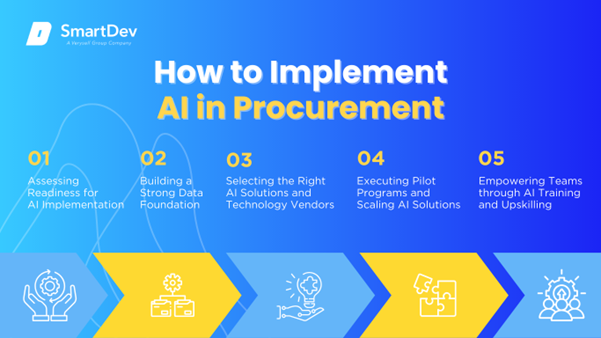
1. Beurteilung der Bereitschaft zur KI-Einführung
Before diving into AI, your company must evaluate their current procurement processes and technological maturity.
Identifying gaps in data availability, digital infrastructure, and stakeholder alignment is crucial.
Without this baseline assessment, AI initiatives may face resistance or deliver suboptimal results.
2. Aufbau einer soliden Datengrundlage
AI thrives on clean, organized data.
Your procurement team should focus on consolidating supplier information, spend data, and contract records into unified systems.
Data governance and integrity must become priorities to ensure accurate and actionable AI outputs.
3. Auswahl der richtigen Tools und Anbieter
The AI landscape offers countless solutions, but not all fit procurement’s unique challenges.
You should prioritize tools that integrate easily with existing systems and offer flexibility for customization.
Selecting experienced, procurement-focused vendors reduces the risk of misalignment.
4. Pilotversuche und Skalierung
Implementing AI should begin with small, controlled pilot projects.
By testing in a limited scope, you can validate effectiveness, adjust workflows, and secure stakeholder buy-in.
Once proven, successful pilots can scale across categories and geographies.
5. Schulungsteams für eine erfolgreiche Implementierung
AI won’t deliver value unless people know how to use it.
Procurement teams need targeted training to understand AI insights and integrate them into daily decisions.
Building AI literacy across the organization ensures smooth adoption and maximizes returns.
Measuring the ROI of AI in Procurement:
Implementing AI in procurement requires ongoing evaluation.
Beyond initial benefits, companies must track performance and quantify impact to justify continued investment.
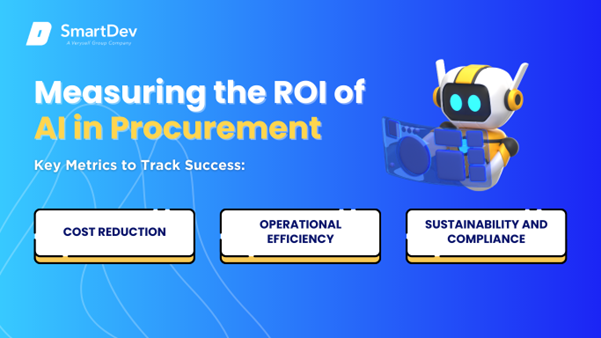
1. Wichtige Kennzahlen zur Erfolgsmessung
Cost reduction will always be a central metric, but AI’s benefits extend far beyond lowering prices.
Procurement leaders should track improvements in procurement cycle times, supplier reliability, and contract compliance.
AI-driven insights also help minimize risks by identifying potential supplier issues early, reducing costly disruptions.
Operational efficiency gains are another clear indicator.
By automating repetitive tasks such as purchase order processing or invoice matching, AI frees up procurement staff to focus on strategic activities.
This shift from transactional work to value-driven initiatives reflects AI’s broader organizational impact.
Sustainability and compliance have become critical measures in modern procurement.
AI helps monitor supplier ESG performance and ensure adherence to regulatory requirements, reinforcing the organization’s reputation and minimizing risk exposure.
2. Fallstudien zum ROI
Real-world applications underscore AI’s transformative potential.
Global manufacturers have shortened sourcing cycles by up to 50%, while retailers have optimized inventory and reduced waste thanks to AI-powered demand forecasting.
Additionally, businesses report improved supplier collaboration and reduced maverick spending through better visibility and analytics.
These examples highlight how AI impacts both the bottom line and operational agility.
While immediate cost savings are attractive, long-term benefits – such as enhanced supplier relationships and increased business resilience – often prove even more valuable.
3. Häufige Fehler und wie man sie vermeidet
Despite the promise, realizing AI’s full ROI is not guaranteed.
Poor data quality can undermine results, leading to inaccurate insights and poor decision-making.
Equally damaging is failing to align AI initiatives with your business objectives or neglecting stakeholder involvement.
Organizations should adopt a phased approach, starting small and scaling based on proven success.
Continuous monitoring and refinement, combined with strong leadership and change management, ensure AI investments deliver sustainable returns.
Future Trends of AI in Procurement:
AI’s evolution is far from over.
As technologies mature and expectations shift, procurement will become a key arena for AI-driven innovation.
Staying ahead requires not only awareness of trends but also a proactive strategy for integration.
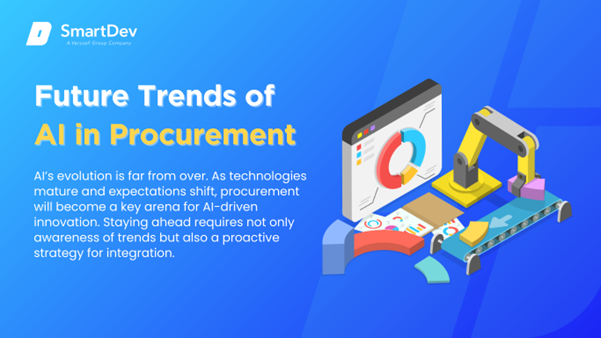
1. Prognosen für das nächste Jahrzehnt
AI will move beyond automating routine tasks to becoming a decision-making partner.
Generative AI and autonomous sourcing agents will assist in creating procurement strategies, drafting supplier communications, and even negotiating contract terms.
These capabilities will enable procurement teams to shift focus from execution to orchestration.
In parallel, real-time data integration will become the norm.
AI will pull insights from internal systems, market intelligence platforms, and supplier networks to create dynamic sourcing strategies.
This will make procurement more adaptive and responsive to sudden market shifts, such as supply chain disruptions or regulatory changes.
Ethische KI and sustainability will also rise in importance.
Companies will increasingly leverage AI to ensure responsible sourcing, traceability, and ESG compliance.
AI will not only find the best price or fastest supplier – it’ll help ensure the best choice for people and the planet.
2. Wie Unternehmen der Konkurrenz immer einen Schritt voraus sein können
Keeping pace with AI’s evolution requires a mindset shift within procurement organizations.
You should foster a culture of continuous learning, encouraging teams to upskill and experiment with new technologies.
Investing in AI partnerships and collaborating with solution providers will also be essential to access cutting-edge capabilities.
Additionally, procurement functions should embed agility into their processes.
As AI tools become more sophisticated, being able to quickly test, adopt, or pivot will separate industry leaders from laggards.
Future-ready procurement teams will combine data fluency, AI literacy, and strategic vision to drive the next wave of enterprise value.
Abschluss
Die wichtigsten Erkenntnisse
AI’s growing role in procurement is no longer experimental – it’s delivering real impact today.
The following key takeaways highlight where AI creates value and what it takes for organizations to harness its full potential.
AI is redefining procurement by enhancing decision-making, automating manual tasks, and adding new layers of intelligence across the supply chain.
From negotiations and sourcing to spend analysis and risk management, AI enables procurement teams to operate with greater speed, accuracy, and strategic focus in an increasingly complex global environment.
Real-world examples show the tangible impact of AI in action.
Zara optimizes inventory to match fast-changing demand, Coca-Cola improves forecasting and logistics to cut costs, and Jaguar Land Rover predicts supply chain risks to avoid disruptions.
These success stories highlight AI’s ability to drive efficiency, resilience, and competitive advantage.
However, realizing AI’s full potential requires careful preparation.
Challenges such as fragmented data, legacy systems, and user adoption cannot be ignored.
You should invest in clean data, integration capabilities, and change management to empower procurement teams to embrace AI as a collaborative, insight-driven partner – not a replacement for human expertise.
Vorwärtskommen: Ein Weg zum Fortschritt
AI in procurement is no longer optional – it’s becoming essential for companies aiming to stay competitive in an increasingly complex and dynamic global market.
By investing now in data readiness, building AI literacy across teams, and selecting scalable, compliant AI solutions, businesses can unlock new levels of efficiency, resilience, and value creation.
Bei SmartDev, we help procurement teams navigate this journey with tailored AI solutions designed to meet real-world sourcing and supply chain challenges.
From intelligent spend analysis and supplier risk prediction to contract automation and ESG monitoring, our experts deliver AI-powered tools that drive measurable impact.
Kontaktieren Sie uns noch heute to explore how we can help transform your procurement operations with AI.
Together, let’s build a smarter, faster, and more strategic procurement function that drives your business forward!
—
Quellen:
- How AI is Transforming Procurement | IBM
- What Impact Will AI Have on Procurement in 2025? | Procurement Magazine
- How Industrial Companies Can Cut Their Indirect Costs Fast | McKinsey & Company
- AI in Procurement Market Report | Market.us
- Ensuring Supply Continuity During Turbulent Times | Ivalua
- Voice of the Supplier Survey 2024 | HICX
- How AI Is Transforming Unilever Ice Cream’s End-to-End Supply Chain | Unilever
- JLR Harnesses Power of AI to Protect and Strengthen Supply Chain | Jaguar Land Rover Media
- Predicting the Future of Demand: How Amazon Is Reinventing Forecasting with Machine Learning | Forbes
- Sustainability in the Supply Chain | Audi



